The Android 5.0 Lollipop Review
by Brandon Chester on December 1, 2014 10:00 AM EST- Posted in
- Smartphones
- Android
- Tablets
- Android 5.0
Notification Drawer
Android was the first of the major smartphone operating systems that we have today to implement the idea of a Notification Drawer. The idea of a screen to store all notifications that can be accessed from anywhere is something that both iOS and Windows Phone 8 have borrowed from Android. Although today it seems like the utility of such a design should be self-evident, it clearly was not, as iOS had previously resorted to intrusive alerts that displayed in the middle of the screen and interrupted the user. The designers behind Android's Notification Drawer certainly deserve a lot of credit for improving the state of notifications on mobile devices. In Android Lollipop the Notification Drawer has been redesigned to display like a list of cards, and has been simplified to include the quick settings page alongside the notifications themselves.
I never quite understood the animation for Notification Drawer in previous versions of Android. If you pull out the drawer in a desk, the first objects you see will be the ones that are closest to the side of the drawer with the handle. This is how the animation for pulling down Notification Centre on iOS functions. But on Android, pulling down Notification Drawer was like pulling down a magic bar that revealed notifications from top to bottom, as though they were already there and the bar somehow revealed them as it went over them. It just didn't really make any sense. In Android Lollipop, Google is clearly displaying each notification as its own separate card, and pulling down the drawer causes them to all expand and slide out from one another. Now it's not much of a drawer, but it's an extremely intricate animation that looks amazing and fits in perfectly with the Material Design aesthetic.
As you'll see above, the quick settings have been integrated into the same section as the notifications themselves. It's now accessed by simply swiping downward a second time after bring down the drawer. I think this works much better than the separate pages that Google was doing previously, which felt more like a way to just throw in quick settings without having to change the design of the drawer beyond the addition of a button. For the most part the settings are the same, but the brightness control is now a slider that can be accessed without having to press anything, and there are a few additions like the Cast screen and Auto-rotate toggles. Google has also finally included a built-in flashlight feature, which may not be welcomed by the developers of ad-ridden flashlight applications, but will certainly be welcomed by users.
The last thing to take note of is the icon in the top right corner. This would normally have your Google avatar, but in my case it's just one of the generic contact icons. Tapping this brings you to the menu where you can add, manage, and switch between multiple user accounts, which is a new feature for phones running Lollipop.
Overall I'm very happy with the new Notification Drawer. It looks better and does more than its previous iteration. My only issue is that it seems that the button to clear all notifications that appears beneath the last notification will not show up if there are too many cards. Swiping upward collapses the list of cards, allowing it to be displayed, but I think Google would be better off just putting it back up top where it was previously so it can always be shown.
Recent Apps
Like the Notification Drawer, Recent Apps also receives a design overhaul in Android Lollipop. What was once a list of square application previews is now something like a stack of cards which displays the full view of every application, although the perspective limits your view to the upper half. The new design also works well with the new animation when accessing it from within an app, which shows the application falling down beneath the navigation buttons and becoming the first card in the stack.
Functionally, it works the same as previous versions of Android for the most part. There is one significant change, and it's specific to Google Chrome users which I would expect is a sizable portion of the Android user base. In Lollipop, tabs in Google Chrome now appear as separate cards in the Recent Apps switcher. This is an interesting move on Google's part because in a way it knocks down a lot of the segregation between native apps and web apps, as web apps will be displayed in the list along with everything else. The only downside to this feature is that it can make it hard to keep track of tabs, and I've actually disabled it in the settings section of Chrome in favor of having the tabs within Chrome itself because I simply have too many tabs open at a single time to have to search for them among every recently opened application.


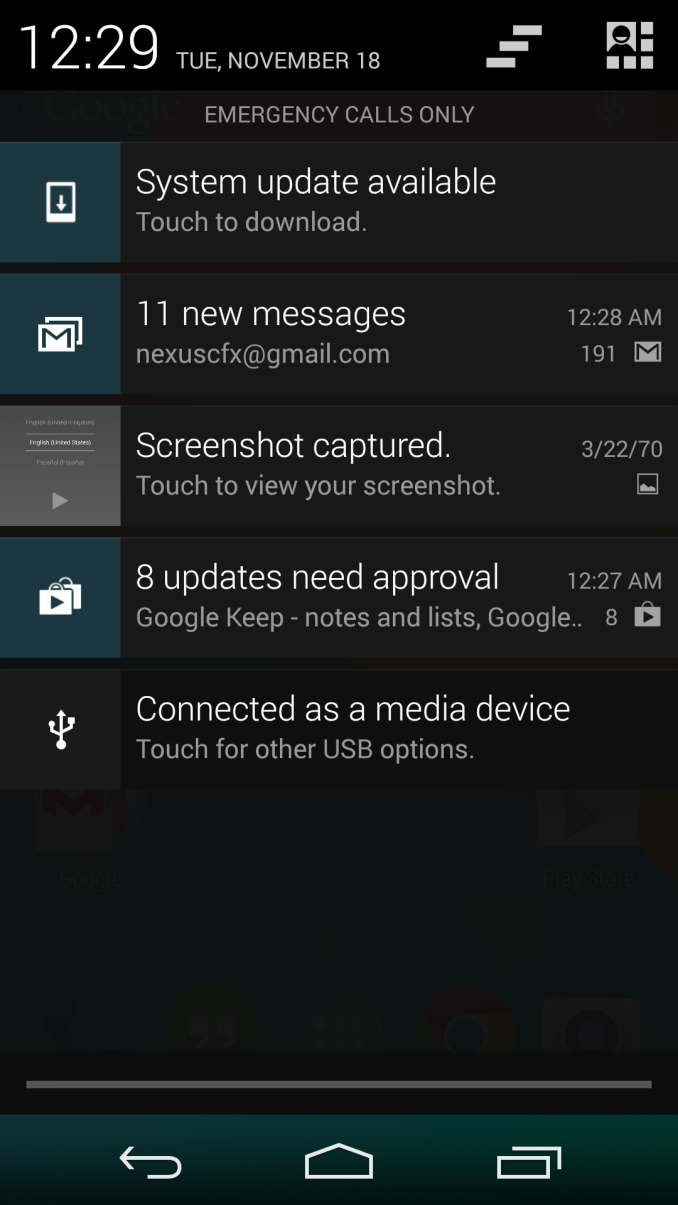
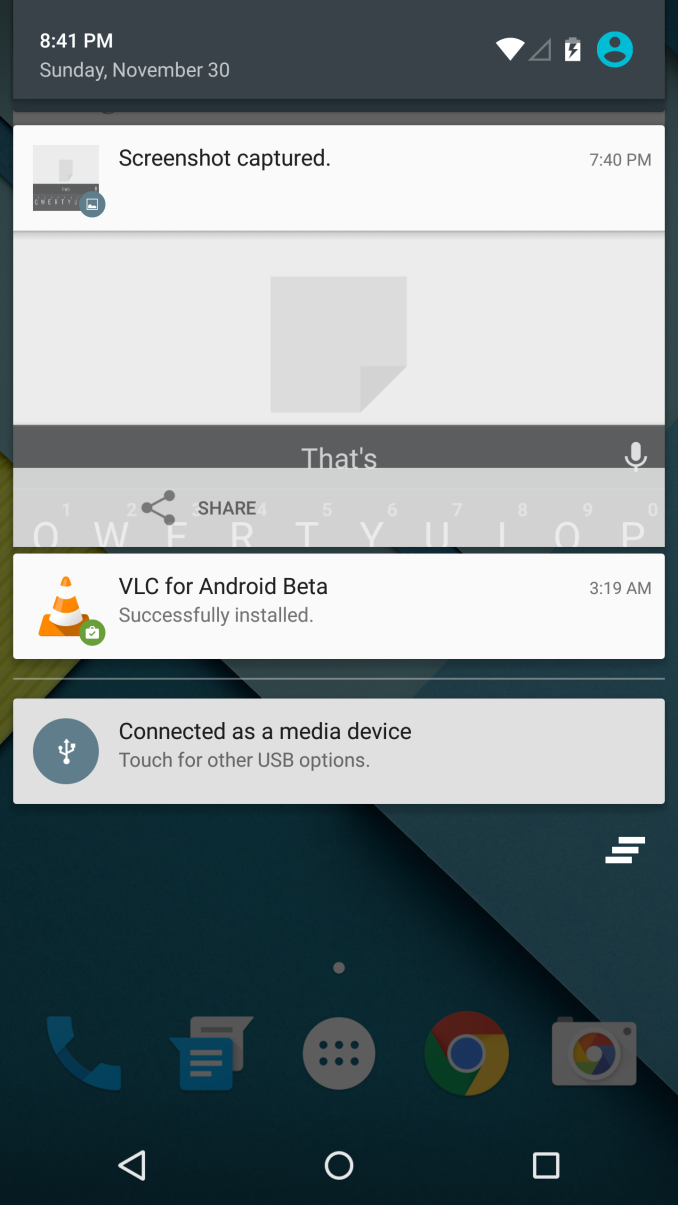
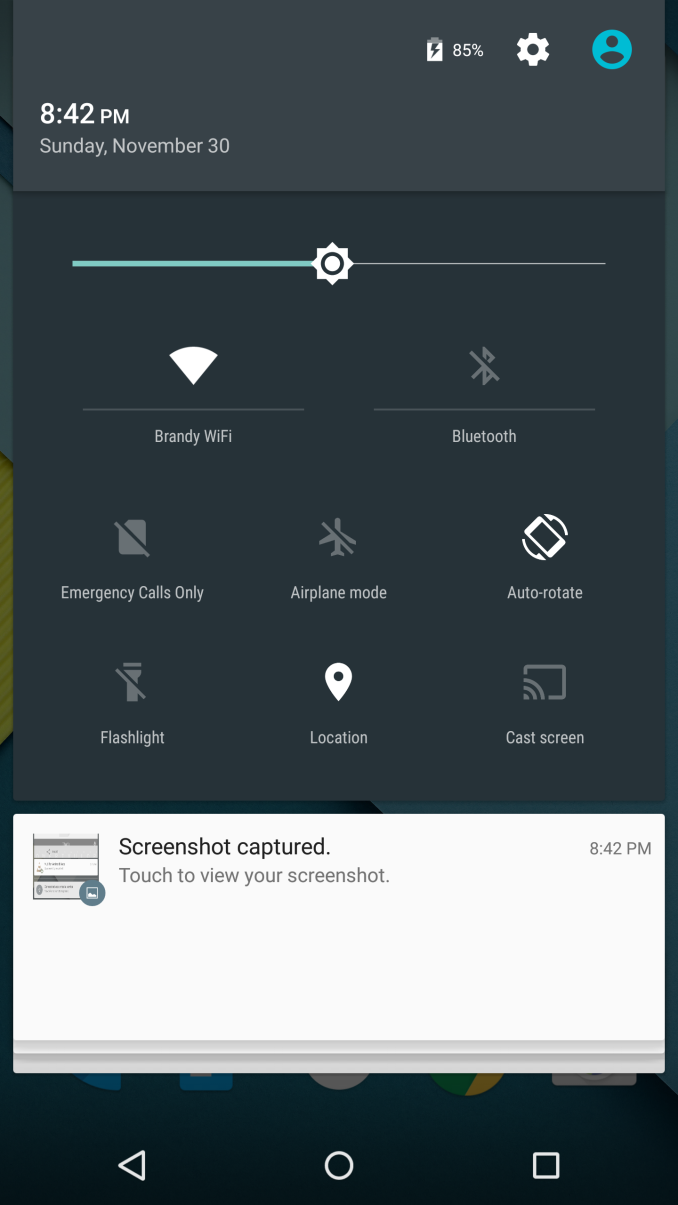
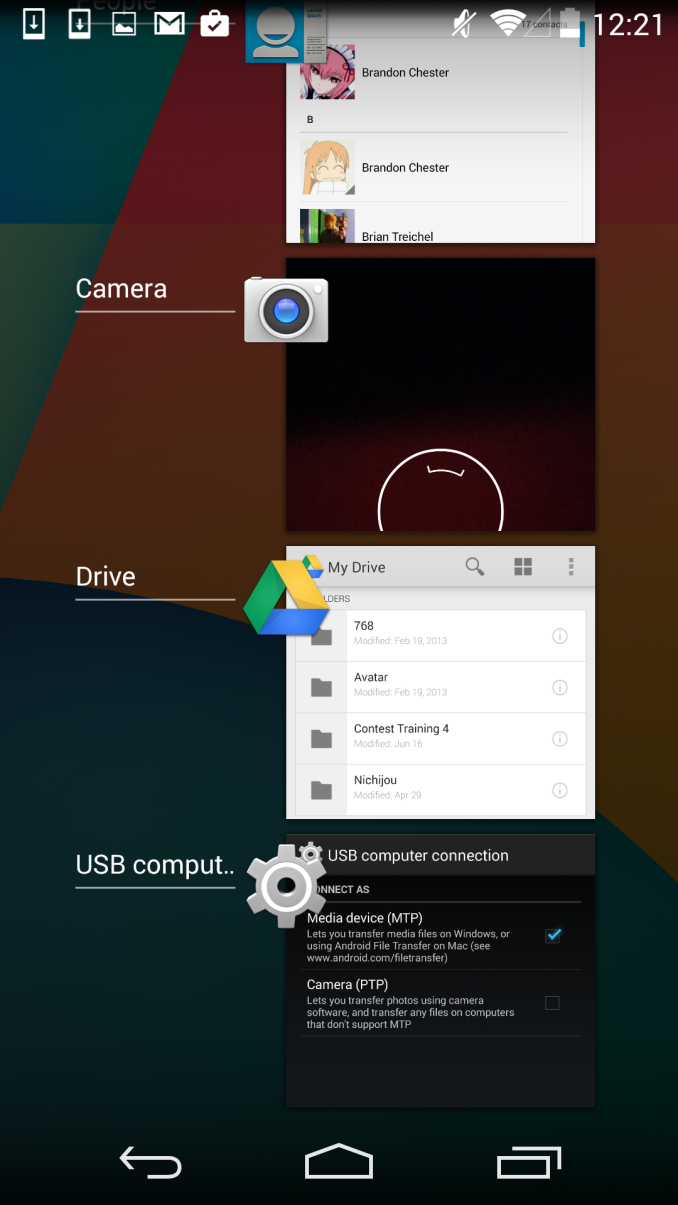
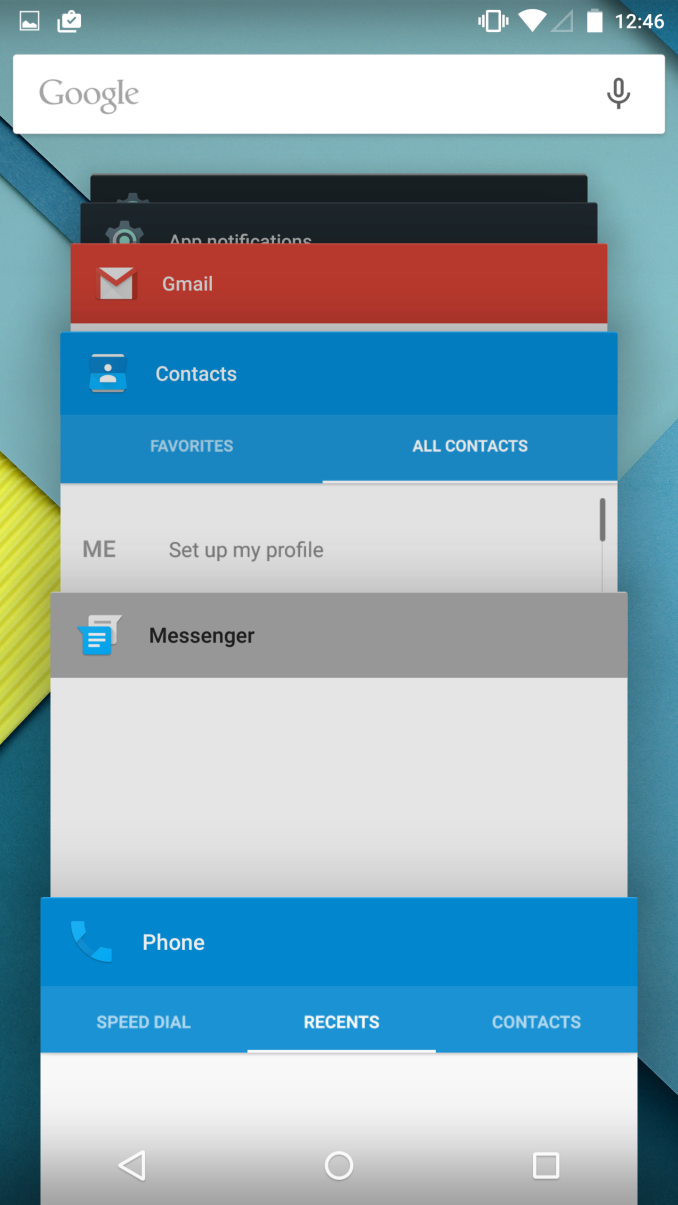








126 Comments
View All Comments
simboss - Monday, December 1, 2014 - link
"In fact, I haven't really noticed any significant bugs at all after upgrading to Lollipop, which says a great deal about the work Google has put into testing to make sure things are stable. "really?
Both my Nexus 5 and 10 have been more unstable with Lollipop, crashing and even getting in a rebooting loop.
What devices have you used to do this testing?
simboss - Monday, December 1, 2014 - link
Adding to that that the default unlocking on the nexus 10 and the notifications are less efficient than they were.Ars had a pretty good summary of it:
http://arstechnica.com/gadgets/2014/11/the-nexus-1...
Brandon Chester - Monday, December 1, 2014 - link
Nexus 5 and Nexus 6. I've had no issues with the former, and I was just speaking from my experience on the matter. I haven't seen any major complaints elsewhere though.JarredWalton - Monday, December 1, 2014 - link
I've had a SHIELD Tablet and Nexus 5 both lock up and require a reboot more often than with 4.4. Might be more of a factor of playing games (PvZ 2, AC Unity Companion), and I don't mind the change in general, but I think we'll see a few updates and maybe 5.0.2 or whatever will be needed before we really clear up the remaining glitches.blzd - Monday, December 1, 2014 - link
Same here with my Nexus 5. It would seem (quite a few others have noticed this as well) that if you don't reboot the phone eventually just dies. It's happened to me twice only to work perfectly again after the reboot, and hasn't happened since I started rebooting nightly.The theory is a memory management/leak bug but it's tough to tell.
Impulses - Tuesday, December 2, 2014 - link
That happened with Kit Kat too tho, if you pummeled Chrome with enough tabs or generally just kept enough things open it'd eventually get weird... Keyboard would act up, my 3G or GPS would occasionally work intermittently, etc. Reboot always fixed it... On face value it sounds less stable than my older Android phones but I never did quite as much on them as on the Nexus 5 either (and/or I'd end up rebooting to flash stuff for features I don't really need anymore).errorr - Monday, December 1, 2014 - link
My Nexus 5 has been great and jank only shows up when it gets hot... Otherwise it has been awesome for me.Unfortunately not so for the wife. She has a memory leak somewhere since the update and her Nexus 5 is almost unusable as everything grinds to a halt.
Jon Tseng - Monday, December 1, 2014 - link
One cool thing I just noticed today - apps can now change colour of status bar to match their UI.Websites can also do this (thought not many are doing it at the moment) e.g. BBC News turns status bar red.
bensulli - Monday, December 1, 2014 - link
Hang on, why no battery life tests? One of Lollipop's biggest draws is Project Volt which claimed an increase of up to 30% in battery life. Anandtech does the most comprehensive battery life evaluations on the internet, why not here?Great article otherwise though! Thanks!
Brandon Chester - Monday, December 1, 2014 - link
I really would have liked to, but Volta has more to do with increasing battery life through better coalescing of CPU and network usage. When you do a battery life test which is just a web browsing or video playback test, none of those improvements have much of an impact. With the current state of mobile and how sandboxing works, it's very hard to build a battery benchmarks that can string together multiple applications being used to simulate a workflow that would get better battery life on Lollipop compared to KitKat.